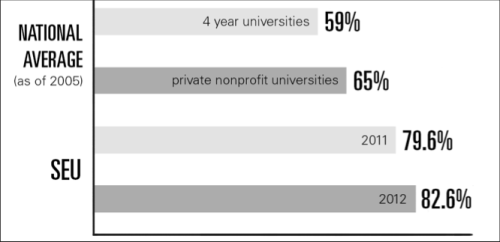Director position increases student retention rate by 3 percent

St. Edward’s student retention rate exceeds national average. National statistics taken from the U.S. Department of Education’s website.
St. Edward’s University prides itself on its retention rate that is well above the national average. But in 2011, a decrease in retention cost the university $2 million, according to Vice President of Financial Affairs Rhonda Cartwright.
This spurred the creation of the position of the Director of University Retention Programs in November of 2012, which is held by Nicole Trevino, to prevent students from leaving St. Edward’s.
In 2011, the retention rate dipped to 79.6 percent. The university’s renewed retention emphasis has successfully helped bring the retention rate back above 80 percent. St. Edward’s has seen an increased retention rate by 3 percent to 82.6 percent since the formation of Trevino’s position.
“We have seen positive effects on our university retention as a result of having a more coordinated community-wide effort on campus,”Trevino said.
For any university, retention is crucial, but it is even more so for St. Edward’s because it operates heavily on income from tuition and not a well-developed endowment fund. However, the shortfall was manageable for the university’s conservative budgeting, according to Cartwright.
“The university compensated for the shortfall by trimming the overall operating budget at all levels,” Cartwright said.
The retention plan focuses on each student on a case-by-case basis because, according to Trevino, St. Edward’s cannot point to one main reason why students transfer. Professors are expected to take attendance and notify their respective school’s liaison to Trevino’s office if any of their students are perceived as struggling.
“It’s my job to contact the student and see how we can help the student as much as possible,” Kim Livingston, liaison for the school of humanities, said. “We try to connect students with resources on campus.”
According to Livingston, St. Edward’s retention rate is one of the best in the country, and their new efforts will help ensure that this high retention rate continues. Livingston said that if a humanities student is struggling she finds whom on campus that student would be most receptive to working with.
Livingston said that the efforts are not new, “The dean of students has always helped students in distress.”
English writing and rhetoric professor Kendall Kelly believes that St. Edward’s attendance policies and retention efforts benefit both the student and the university. Kelly previously taught at Texas State University, where she was not required to take attendance, but she did so anyway.
“Generally if you don’t take attendance, students don’t show up. And, if they don’t show-up, they don’t learn,” Kelly said. Although Trevino could not point to one reason that students transfer, Kelly said that in her experience the burden to pay for college tuition at St. Edward’s is a large factor.
This was the case for Meg Frey who came to St. Edward’s as a freshman in the fall of 2011, but she quickly realized that an education from St. Edward’s simply was not feasible for her family.
She was under the impression that she would receive more scholarship than she did and transferred to Texas State after one semester at St. Edwards because she could not afford tuition.
St. Edward’s “provided me with enough financial aid, so I could pay what I owed,” she said.






